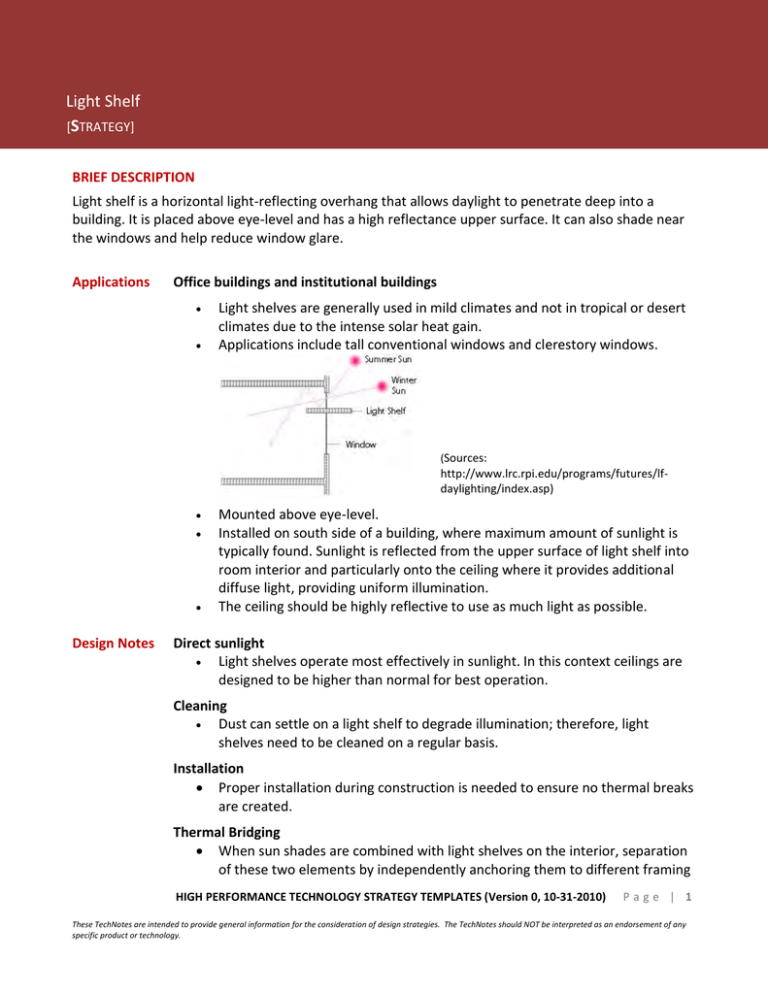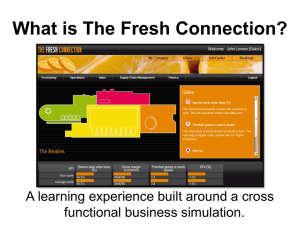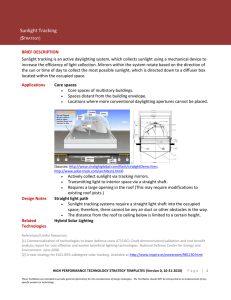Light Shelf S
advertisement

Light Shelf [STRATEGY] BRIEF DESCRIPTION Light shelf is a horizontal light-reflecting overhang that allows daylight to penetrate deep into a building. It is placed above eye-level and has a high reflectance upper surface. It can also shade near the windows and help reduce window glare. Applications Office buildings and institutional buildings Light shelves are generally used in mild climates and not in tropical or desert climates due to the intense solar heat gain. Applications include tall conventional windows and clerestory windows. (Sources: http://www.lrc.rpi.edu/programs/futures/lfdaylighting/index.asp) Design Notes Mounted above eye-level. Installed on south side of a building, where maximum amount of sunlight is typically found. Sunlight is reflected from the upper surface of light shelf into room interior and particularly onto the ceiling where it provides additional diffuse light, providing uniform illumination. The ceiling should be highly reflective to use as much light as possible. Direct sunlight Light shelves operate most effectively in sunlight. In this context ceilings are designed to be higher than normal for best operation. Cleaning Dust can settle on a light shelf to degrade illumination; therefore, light shelves need to be cleaned on a regular basis. Installation Proper installation during construction is needed to ensure no thermal breaks are created. Thermal Bridging When sun shades are combined with light shelves on the interior, separation of these two elements by independently anchoring them to different framing HIGH PERFORMANCE TECHNOLOGY STRATEGY TEMPLATES (Version 0, 10-31-2010) Page | 1 These TechNotes are intended to provide general information for the consideration of design strategies. The TechNotes should NOT be interpreted as an endorsement of any specific product or technology. Light Shelf [STRATEGY] and then isolating them using lapped insulation is an effective way to eliminate or limit thermal bridge at the anchor. For example, sun shades can be anchored to the steel stud framing of the panel system and light shelves can be anchored to the inner wall system framing. Related Technologies Daylighting Photosensor References/Useful Resources: [1] The Encyclopedia of Alternative Energy and Sustainable Living. Available at http://www.daviddarling.info/encyclopedia/L/AE_light_shelf.html [2] Energy Efficiency Manual. Donald Wulfingoff. 1999. Energy Institute Press. [3] Reference: The Effects of Thermal Bridging at Interface Conditions. http://www.thebestconference.org/best1/pdfs/034.pdf HIGH PERFORMANCE TECHNOLOGY STRATEGY TEMPLATES (Version 0, 10-31-2010) Page | 2 These TechNotes are intended to provide general information for the consideration of design strategies. The TechNotes should NOT be interpreted as an endorsement of any specific product or technology. Light Shelf [ENERGY AND ENVIRONMENT] Energy Savings Lighting Energy The width of the daylighting zone along the exterior wall extends into the space 10 to 20 feet, which translates to electricity savings of 10 to 40 watts per foot along the wall. Cooling and Heating Energy The heat energy added to the space is not much different from what would be added by an equivalent amount of electric lighting. Demand Charges Guiding Principles Light shelves can yield to a reduction in monthly demand charges due to reduced lighting energy during peak hours. Optimize Energy Performance (Energy Efficiency) Reduce the energy use by 30 percent compared to the baseline building performance rating per ASHRAE Standard 90.1-2007. Enhance Indoor Environmental Quality (Daylighting) Achieve a minimum daylight factor of 2 percent in 75 percent of all space occupied for critical visual tasks. Provide automatic dimming controls or accessible manual lighting controls, and appropriate glare control. Associated LEED Credits (NC 2009) EAc1: Optimize Energy Performance (1-19 points) Demonstrate a percentage improvement in energy performance compared to a baseline performance per ASHRAE/IESNA Standard 90.1-2007. IEQc8.1: Daylight and Views—Daylight (1 point) Achieve daylighting in 75 percent of regularly occupied spaces. HIGH PERFORMANCE TECHNOLOGY STRATEGY TEMPLATES (Version 0, 10-31-2010) Page | 3 These TechNotes are intended to provide general information for the consideration of design strategies. The TechNotes should NOT be interpreted as an endorsement of any specific product or technology. Light Shelf [PRODUCT AND ECONOMICS] [ENERGY AND ENVIRONMENT] Product Images (Sources: http://www.alcoa.com/global/en/products/product.asp?prod_id=1852; http://www.greenedu.com/blog/2009/10/19/light-shelves-and-leed.html) Components Light shelf, Window, Ceiling, Shading device Cost range A light shelf unit itself costs about $100 per window, but is subject to variation. Product types Exterior light shelf Exterior light shelves can be combined with shading devices, installed at the same height as the light shelves, which is below the tops of the windows. The system keeps direct sunlight from entering the portions of the windows below the light shelves. It can increase daylighting by reflecting more light farther into the space. The exterior shade needs a reflective upper surface and the window should extend well above the exterior shade. Interior light shelf Interior light shelves are available in various materials and in fixed and operable configurations. Tilting a light shelf makes the top surface easier to clean. A small amount of tilt may also improve performance. Tilting the shelf downward increases penetration of light into the space, but introduces the possibility of increasing glare. Tilting the shelf upward may avoid glare and increase daylighting at low sun angles. Vendors InLighten™ Light Shelf (Material: Aluminum) http://www.alcoa.com/global/en/products/product.asp?prod_id=1852 Nysan Light Shelf (Material: Metal and others) http://www.hunterdouglascontract.com/solarcontrol/lightshelves/ HIGH PERFORMANCE TECHNOLOGY STRATEGY TEMPLATES (Version 0, 10-31-2010) Page | 4 These TechNotes are intended to provide general information for the consideration of design strategies. The TechNotes should NOT be interpreted as an endorsement of any specific product or technology. Light Shelf [PRODUCT AND ECONOMICS] [ENERGY AND ENVIRONMENT] Doralco - Architectural Metal Solutions http://www.doralco.com/light_shelves.php Warranty Info Unknown Code Restrictions None HIGH PERFORMANCE TECHNOLOGY STRATEGY TEMPLATES (Version 0, 10-31-2010) Page | 5 These TechNotes are intended to provide general information for the consideration of design strategies. The TechNotes should NOT be interpreted as an endorsement of any specific product or technology. Light Shelf [SPECIFICATIONS] Consider the following when preparing specifications:1 A. Light shelves are to be used for south facing windows to maximize daylight potential. B. Light shelves should be mounted at a height above the floor that does not interfere with passers-by. C. Maximum light shelf projection is 30inches from back of glazed wall system. D. It is suggested that a white finish be used for upper surface of a light shelf to maximize the reflection of daylight in the space. E. Consult with local building and fire codes for applications with light shelves and fire sprinkler systems. F. Some light shelves can be integrated with a certain type of curtain wall and sun control systems. Check the compatibility before installation. 1 Specification language modified from InLighten® (Light Shelf) Architectural Detail Manual http://www.alcoa.com/kawneer/north_america/catalog/pdf/InLighten__E--A.pdf HIGH PERFORMANCE TECHNOLOGY STRATEGY TEMPLATES (Version 0, 10-31-2010) Page | 6 These TechNotes are intended to provide general information for the consideration of design strategies. The TechNotes should NOT be interpreted as an endorsement of any specific product or technology. Daylighting Photosensor [CASE STUDY] Naval Base Ventura County – Building 8502 Port Hueneme, California Site Location Facility Approach Results Building 850 fully demonstrated sustainable design and construction practices that can be applied to other Navy projects and facilities throughout the Federal government. The building serves as a learning center where technologies are highlighted and displayed, including an interactive touch screen computer kiosk that provides a real-time view of building energy demands and green features. The design makes use of 100 percent natural daylighting during normal working hours. Light shelves in Building 850 bring daylight into the building. Daylighting incorporated with natural ventilation systems helped downsize HVAC equipment. The design team estimated that Building 850 would save 64 percent in lighting (including savings from high-efficiency lighting systems and daylighting sensors) and 43 percent in cooling expenses each year. (Source: http://www.p2pays.org/ref/41/40930.pdf) 2 Case study courtesy of DOE High Performance Buildings Database. http://femp.buildinggreen.com/overview.cfm?projectid=51 HIGH PERFORMANCE TECHNOLOGY STRATEGY TEMPLATES (Version 0, 10-31-2010) Page | 7 These TechNotes are intended to provide general information for the consideration of design strategies. The TechNotes should NOT be interpreted as an endorsement of any specific product or technology.





